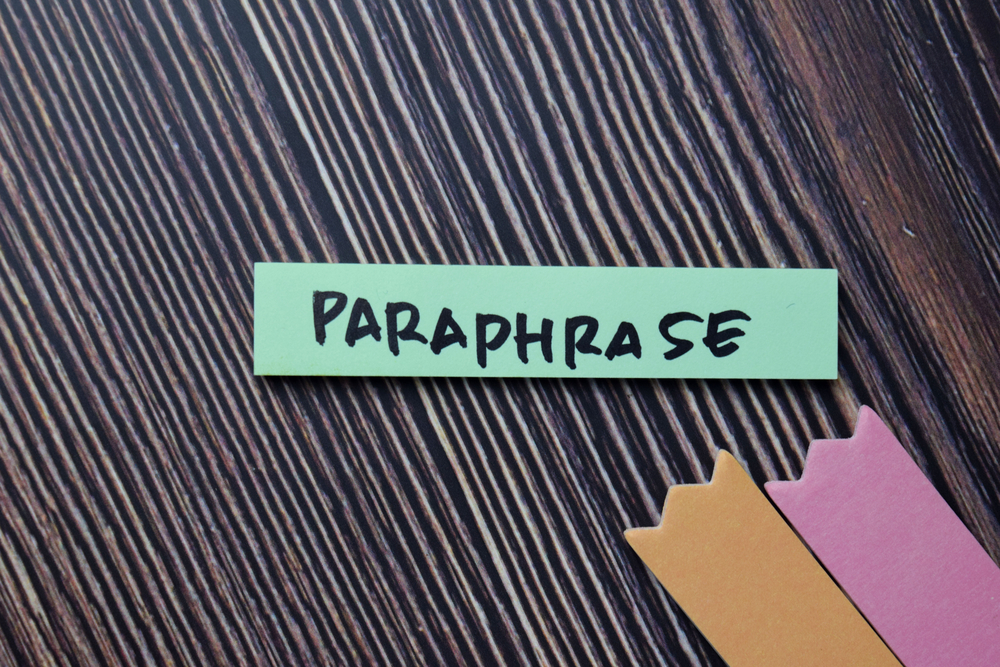September 26, 2023
What Are Five Paraphrasing Techniques?
Not quite sure how to paraphrase? We can help. There are a few techniques that make it easier for you to paraphrase.
- Change the Sentence Structure
- Use Synonyms
- Change the Word Form
- Change the Grammar
- Use Multiple Techniques
How to Change the Sentence Structure
One of the easiest ways to paraphrase is by changing the sentence structure. The great thing about this technique is that it can help you clear up any ambiguities in the original text.
One of the easiest ways to do this is by switching the object and subject of the sentence. Here are some examples:
Jackie is the head nurse at General Hospital.
The head nurse at General Hospital is Jackie.
Mark won the Mr. Universe contest.
The winner of the Mr. Universe contest was Mark.
Students in psychology also need to understand sociology.
Understanding sociology is essential for psychology students.
Use Synonyms
Another great way to paraphrase is by using synonyms. That can be a great starting block for paraphrasing.
However, you should be aware that just changing one word will not be enough to avoid plagiarizing. Instead, it would help if you used multiple synonyms.
Look at the example below. We used a synonym to avoid a direct quotation, but the sentence is otherwise unchanged:
Jackie is the head nurse at General Hospital.
Jackie is the lead nurse at General Hospital.
For that sentence, the change is not enough to seem original. Furthermore, there are only a few ways to change the rest of the sentence since General Hospital and Jackie are both proper nouns. Generally, there are no synonyms for proper nouns. However, you can use the idea of a synonym, even with proper nouns. Assume that Jackie’s full name is Jackie Smith and that General Hospital is located in Manhattan. A good paraphrase using the idea of synonyms as well as an actual synonym would be:
Ms. Smith is the lead nurse at Manhattan’s General Hospital.
The above sentence means the exact same thing as the original sentence. Still, it is so different that it is wholly paraphrased. You would not need to include a citation to that information, because it does not contain the type of information you need to cite. So, when you are looking to paraphrase, remember that you can generally find synonym-like substitutions for proper nouns.
While synonyms are the easiest thing to use, some words are unique. You may want to consider whether they have an antonym in those instances. For example, while heaven and hell have similar places in other religions, they are pretty unique in Judeo-Christian theology. So, for hell, you could try substituting something like the opposite of heaven. It is not as concise as using a synonym, but depending on what you have to paraphrase, it may be your best bet.
Change the Word Form
For most words, it is easy to change their form. Words come in four primary categories. Nouns, verbs, adjectives, and adverbs. You can play around with those different forms to convey the same meaning but in a different manner.
Tyrone helped lead the football team to victory.
Tyrone was victorious as the football team’s leader.
In the above example, we changed the verb helped lead to the adjective leader. We also changed the noun victory to victorious. These changes keep the sentence’s meaning but present it in an entirely new form.
Change the Grammar
Grammatical structure can make a huge difference in a sentence. It is a great way to paraphrase, but you must be careful. For example, changing the verb tense can also change the meaning. However, changing from a passive sentence to an active sentence allows you to preserve meaning in most cases and improves your writing structure.
John went to the store.
John goes to the store.
Look at the above sentences. Do they have the same meaning? Without context, it is difficult to tell. That is because verb tenses can make a huge difference.
A better substation for the first sentence would be to combine it with your following sentence and make it an introductory clause:
John had gone to the store when he noticed he left his wallet at home.
Just like verb tenses, active and passive voice can change the meaning of your sentence. Sometimes, events happen to a person. They can be challenging to move into a passive format. For example, let us say that you have a sentence like this one:
Julia was sexually assaulted.
You cannot change that sentence into an active sentence without adding an additional noun to the sentence. After all, Julia did not do the assaulting. However, do not get stuck in a box thinking you cannot add nouns to a sentence.
An unknown assailant sexually assaulted Julia.
Here, you have changed the sentence to an active sentence and changed the form of your noun while preserving the sentence’s meaning. So, remember that changing the grammatical structure may mean adding words. That is fine as long as you maintain the meaning of the original sentence.
Combine the Techniques
If you want to become a great paraphraser, then you will want to combine techniques. Using multiple techniques together will help you dramatically change the appearance of your sentence so that it does not resemble the original sentence. However, you will still be able to preserve the original meaning.
View 120,000+ High Quality Academic Documents
Learn-by-example to improve your academic writing
What Are Three Examples of Paraphrasing?
To see the different techniques people use to paraphrase, we can look at three examples of paraphrasing using the same source material. Alexander Pope has a famous quotation:
To err is human; to forgive, divine.
So, let us look at how to apply techniques to paraphrase this famous quote.
If we change the sentence structure, we could write:
To forgive is divine; to err is human.
If we use synonyms, we could write:
To make mistakes is human; to offer absolution is godly.
Changing grammatical structure, we could write:
Erring is human; forgiving is divine.
What is one thing that all three of these paraphrases have in common? Frankly, they are not as good as the original. That is one of the reasons that we do not generally paraphrase famous quotations and aphorisms, especially ones like this one, that have made their way into daily use. So, keep that in mind when you are working on paraphrasing. Is the material the type that needs to remain a quotation, or is it well-suited for paraphrasing?
How Do I Cite a Paraphrase?
Many of our students wonder how to cite a paraphrase. That is a great question. Not all paraphrased sentences need to be cited. You must cite the source if you are using words, research, information, data, and ideas that are not yours. If a fact comes from a specific source, you should cite it. So, the first thing you need to consider when citing a paraphrase is whether you need to cite it.
You must cite quotations and put them in quotation marks. You may need to provide a citation if you paraphrase a sentence by substituting a word or phrase. It depends on whether that information is available from multiple sources. If you summarize information from a particular source, you also want to provide a citation. Anytime you provide facts, statistics, dates, or information, you want to cite it. However, this is not true for a well-known fact. For example, you would not need to provide a citation for the following sentence:
July 4, 1776, was Independence Day in the United States.
You do not need to cite general information. Finding the same fact in multiple sources probably falls under the general or common knowledge category. You do not need to cite if you can easily observe a fact or if it is generally accepted. Making that determination may depend on your field of study.
For example, suppose you are a high school student writing a paper about polycystic ovarian syndrome. In that case, you might need to provide a citation for this sentence:
Polycystic Ovarian Syndrome is linked to metabolic syndrome, infertility, excess body hair, and irregular periods.
However, that information may be considered general knowledge if you are a biology major. So, when deciding whether to cite a source, it is important to consider general knowledge in your field.
Once you have determined that you need to cite your paraphrase, you must choose the appropriate way to cite it. That will depend on what style guide you are using to write your paper.
For MLA, you cite by using the author’s name and page number in parenthesis following the paraphrased material. It looks like this:
The quick brown fox jumped over the lazy dog (Smith 315).
For APA, you use the author’s last name and the year of publication. It looks like this:
The quick brown fox jumped over the lazy dog (Smith, 1993).
In APA, a direct quotation also uses the page number. However, for a paraphrase, you do not include the page number.
In Chicago, you use the author’s last name, the date, and the page number. It looks like this:
The quick brown fox jumped over the lazy dog (Smith 1993, 315).
Turabian citations look the same as Chicago citations.
For footnotes or endnotes, you will cite paraphrased material the same way as quoted material.
Just keep in mind that paraphrased material does not go inside quotation marks. If you are using quotation marks, it should be material directly taken from the source.

What Are the Four Qualities of a Good Paraphrase?
Do you want to know what makes an excellent paraphrase? These four qualities can help you ensure that your paraphrase captures the gist of the original information.
- It includes all of the critical information.
- It is in your own words.
- It is shorter than or the same length as the original.
- You have the source included in your reference list and the text if the paraphrase contains any of the information requiring a citation.
Examples of Paraphrase
Sometimes, the concept of paraphrasing can seem challenging. No wonder so many people ask us what is an example of paraphrasing. We decided to show you how paraphrasing quotes is easier than you think. So, read on for some paraphrasing examples:
“You must be the change you wish to see in the world.” Mahatma Gandhi
If you want the world to change, you need to change it.
“Whatever you are, be a good one.” Abraham Lincoln
Do your best at whatever you choose to do.
“United we stand, divided we fall.” Aesop
We fall if we are separated, but stand when we are together.
“Tis better to have loved and lost than never to have loved at all.” Alfred Lord Tennyson
Never loving is worse than loving and losing.
“The only thing we have to fear is fear itself.” Franklin D. Roosevelt
We have nothing to be scared of other than fear.
“Speak softly and carry a big stick.” Theodore Roosevelt
Whisper and carry a log.
Wait, that is a terrible paraphrase. It does not convey what Roosevelt was attempting to convey at all. His quote means that diplomacy does not mean threats and bluster. Instead, you can be polite if your enemy knows you have strength and might. However, that is a lengthy paraphrased statement. We included this example to remind you that you need to look at more than the actual meaning of the words in the original material. You have to look at the connotation, as well.
Get Help Paraphrasing
Need help with paraphrasing? Check out our paraphrasing tool today!
Take the first step to becoming a better academic writer.

